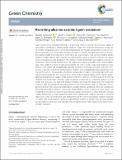Revisiting alkaline aerobic lignin oxidation
Author(s)
Schutyser, Wouter; Kruger, Jacob S; Robinson, Allison M; Katahira, Rui; Brandner, David G; Cleveland, Nicholas S; Mittal, Ashutosh; Peterson, Darren J; Meilan, Richard; Román-Leshkov, Yuriy; Beckham, Gregg T; ... Show more Show less
DownloadAccepted version (3.868Mb)
Terms of use
Metadata
Show full item recordAbstract
© The Royal Society of Chemistry 2018. Lignin conversion to renewable chemicals is a promising means to improve the economic viability of lignocellulosic biorefineries. Alkaline aerobic oxidation of lignin has long been employed for production of aromatic compounds such as vanillin and syringaldehyde, but this approach primarily focuses on condensed substrates such as Kraft lignin and lignosulfonates. Conversely, emerging lignocellulosic biorefinery schemes enable the production of more native-like, reactive lignin. Here, we revisit alkaline aerobic oxidation of highly reactive lignin substrates to understand the impact of reaction conditions and catalyst choice on product yield and distribution. The oxidation of native poplar lignin was studied as a function of temperature, NaOH loading, reaction time, and oxygen partial pressure. Besides vanillin and syringaldehyde, other oxidation products include acetosyringone and vanillic, syringic, and p-hydroxybenzoic acids. Reactions with vanillin and syringaldehyde indicated that these compounds are further oxidized to non-aromatic carboxylic acids during alkaline aerobic oxidation, with syringaldehyde being substantially more reactive than vanillin. The production of phenolic compounds from lignin is favored by high NaOH loadings and temperatures, but short reaction times, as the products degrade rapidly, which is further exacerbated by the presence of oxygen. Under optimal conditions, a phenolic monomer yield of 30 wt% was obtained from poplar lignin. Testing a range of catalysts showed that Cu-containing catalysts, such as CuSO4 and LaMn0.8Cu0.2O3, accelerate product formation; specifically, the catalyst does not increase the maximum yield, but expands the operating window in which high product yields are obtainable. We also demonstrate that other native and isolated lignin substrates that are significantly chemically modified are effectively converted to phenolic compounds. Finally, alkaline aerobic oxidation of native lignins was compared to nitrobenzene oxidation and reductive catalytic fractionation, as these methods constitute suitable benchmarks for lignin depolymerization. While nitrobenzene oxidation achieved a somewhat higher yield, similar monomer yields were obtained through RCF and alkaline aerobic oxidation, especially for lignins with a high guaiacyl- and/or p-hydroxyphenyl-content, as syringyl units are more unstable during oxidation. Overall, this study highlights the potential for aerobic lignin oxidation revisited on native-like lignin substrates.
Date issued
2018Department
Massachusetts Institute of Technology. Department of Chemical EngineeringJournal
Green Chemistry
Publisher
Royal Society of Chemistry (RSC)